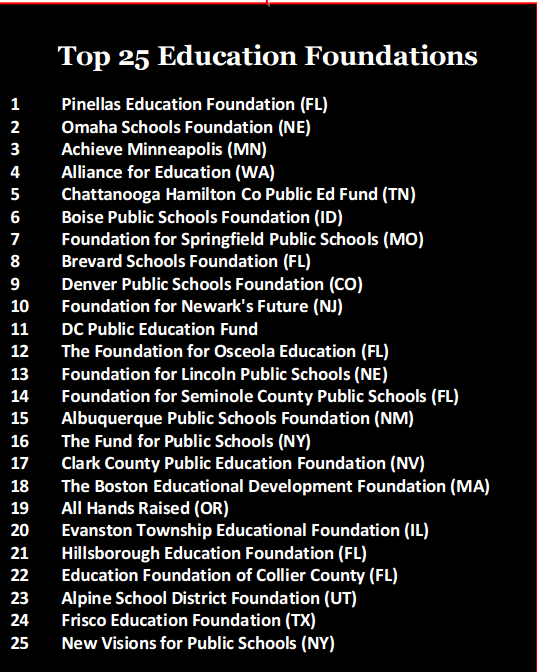Ranking the Nation’s Best Local Education Foundations
Local education foundations hold more than $500 million in assets and are pouring at least $160 million into K-12 grants and programs, according to a new report, which ranks the philanthropies on their overall quality, including their ability to raise money and channel it to schools in their communities.
Florida’s foundations fare especially well in the rankings, with 11 foundations landing in the top 50. Texas has eight in the top 50, but just one in the top 25.
The Pinellas Education Foundation, in the Tampa Bay area, ranks first—a spot it has held for three years in a row—followed by the Omaha Schools Foundation, in Nebraska, and Achieve Minneapolis. (See a full list of the top 25, below.)
The Alliance for Education, in Seattle, Wash. and the Chattanooga Hamilton County Public Education Fund, in Tennessee, took fourth and fifth in the rankings.
This is the fourth year that the report, “Stepping Up: The Nation’s Top Education Foundations,” has been released, and the third year in a row of its publication. It was issued this week by the Caruthers Institute, formerly known as dewey & associates, a nonprofit think tank that conducts research on and advocates for children’s issues.
Stepping Up uses a methodology that judges foundations’ performance in four broad areas: the resources they devote to enhancing public education; their long-term financial sustainability; the resources they invest in K-12 programs; and their human capital.
More specifically, the report uses eight “performance categories” to rank the foundations: total revenues; revenues per student; total assets; assets per student; grant and program expenses; grant and program expenses per student; investment income; and their volunteer forces.
The money that K-12 districts are able to raise on their own is typically committed, by law or custom, to specific obligations, noted Dewey Caruthers, the president of the institute, in an interview. Those restrictions make financial resources that foundations raise especially important for school systems, because there are so many other areas of need, he said.
In general, many of the K-12 foundations play an especially big role in supporting art and music programs, career-prep efforts, and dropout prevention, among other areas, Caruthers said.
Many of the best foundations have broad networks of volunteers and an ability to convey educational priorities to communities in ways that school districts themselves may not, he added.

The Stepping Up report lists 188 K-12 education foundations from 220 school districts around the country. The authors say that their goal is to rank the foundations based on their performance metrics, regardless of the size of the district they support.
Of the foundations ranked in the top 15, just two of them are serving districts with more than 100,000 students: in Pinellas County, and Albuquerque, N.M.
The high rankings of foundations located in states and communities around the country is both encouraging, and a sign of how school districts have come to rely on those philanthropies and recognize their value, Caruthers said.
“It shows the strength of the concept of K-12 foundations” he said, and their ability to do “big things for a school district.”
See also:
